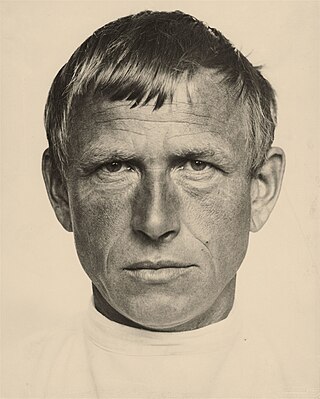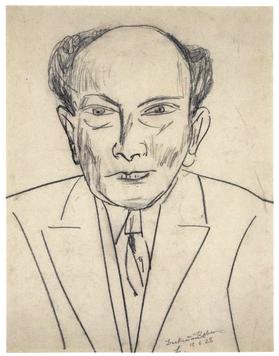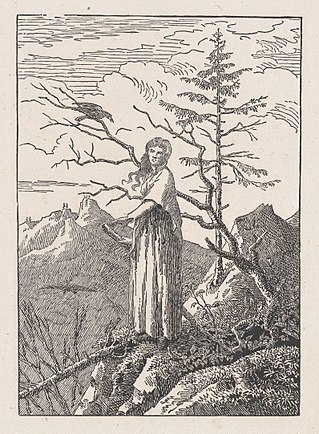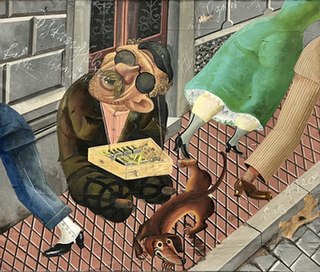External links
- Metropolitan Museum of Art, Glitter and Doom Special Exhibit official website
- Art in New York City, November 2006 issue Archived 2007-09-30 at the Wayback Machine
Glitter and Doom is the name of a Special Exhibit formerly shown at the Metropolitan Museum of Art featuring portrait art of Germany from 1919-1933, between the World Wars when the Weimar Republic was in political power. This Special Exhibit Archived 2007-02-14 at the Wayback Machine was shown from November 16, 2006 to February 19, 2007.
Life in the Weimar Republic was marked by massive hyperinflation, crippling poverty, and political upheaval. The massive number of orphans and widows without a means of feeding themselves resulted in prostitution on a scale not seen before in Germany. Additionally, the repeal and relaxation of laws forbidding prostitution, homosexuality, and other 'moral vices' led to an explosion of an underground culture, with people enjoying pursuits not available in other European Cities.
Themes of the works include sexual freedom, prostitution, poverty, war profiteering, disfigurement and decay, homosexuality, and transvestites.
The exhibition was organized by Sabine Rewald, Jacques and Natasha Gelman Curator in the Department of Nineteenth-Century, Modern, and Contemporary Art.
The works of this exhibit can be found in the book Glitter and Doom Archived 2007-03-02 at the Wayback Machine , by Yale University Press.

Wilhelm Heinrich Otto Dix was a German painter and printmaker, noted for his ruthless and harshly realistic depictions of German society during the Weimar Republic and the brutality of war. Along with George Grosz and Max Beckmann, he is widely considered one of the most important artists of the Neue Sachlichkeit.

Weimar culture was the emergence of the arts and sciences that happened in Germany during the Weimar Republic, the latter during that part of the interwar period between Germany's defeat in World War I in 1918 and Hitler's rise to power in 1933. 1920s Berlin was at the hectic center of the Weimar culture. Although not part of the Weimar Republic, some authors also include the German-speaking Austria, and particularly Vienna, as part of Weimar culture.

Post-Impressionism was a predominantly French art movement that developed roughly between 1886 and 1905, from the last Impressionist exhibition to the birth of Fauvism. Post-Impressionism emerged as a reaction against Impressionists' concern for the naturalistic depiction of light and colour. Its broad emphasis on abstract qualities or symbolic content means Post-Impressionism encompasses Les Nabis, Neo-Impressionism, Symbolism, Cloisonnism, the Pont-Aven School, and Synthetism, along with some later Impressionists' work. The movement's principal artists were Paul Cézanne, Paul Gauguin, Vincent van Gogh and Georges Seurat.

The New Objectivity was a movement in German art that arose during the 1920s as a reaction against expressionism. The term was coined by Gustav Friedrich Hartlaub, the director of the Kunsthalle in Mannheim, who used it as the title of an art exhibition staged in 1925 to showcase artists who were working in a post-expressionist spirit. As these artists—who included Max Beckmann, Otto Dix, George Grosz, Christian Schad, Rudolf Schlichter and Jeanne Mammen—rejected the self-involvement and romantic longings of the expressionists, Weimar intellectuals in general made a call to arms for public collaboration, engagement, and rejection of romantic idealism.
Katherine Porter was an American visual artist. Porter is considered one of the most important contemporary artists associated with Maine. She resisted categorization. Through the medium of painting and drawing her canvases convey the conflict inherent in life. She expressed her ideas with a visual vocabulary that was "geometric and gestural, abstract and figurative, decorative and raw, lyric and muscular."
The Golden Twenties was a particular vibrant period in the history of Berlin. After the Greater Berlin Act, the city became the third largest municipality in the world and experienced its heyday as a major world city. It was known for its leadership roles in science, the humanities, art, music, film, architecture, higher education, government, diplomacy and industries.

John Rewald was an American academic, author and art historian. He was known as a scholar of Impressionism, Post-Impressionism, Cézanne, Renoir, Pissarro, Seurat, and other French painters of the late 19th century. He was recognized as a foremost authority on late 19th-century art. His History of Impressionism is a standard work.
Heinrich Maria Davringhausen was a German painter associated with the New Objectivity.
Marion M. Bass, known as Pinky Bass or Pinky/MM Bass, is an American photographer, known for her work in pinhole photography.

Water Lilies is a series of approximately 250 oil paintings by French Impressionist Claude Monet (1840–1926). The paintings depict his flower garden at his home in Giverny, and were the main focus of his artistic production during the last thirty years of his life. Many of the works were painted while Monet suffered from cataracts.

Fauvism is a style of painting and an art movement that emerged in France at the beginning of the 20th century. It was the style of les Fauves, a group of modern artists whose works emphasized painterly qualities and strong colour over the representational or realistic values retained by Impressionism. While Fauvism as a style began around 1904 and continued beyond 1910, the movement as such lasted only a few years, 1905–1908, and had three exhibitions. The leaders of the movement were André Derain and Henri Matisse.

The American Jewish Museum, or AJM, is a contemporary Jewish art museum located in Pittsburgh, Pennsylvania. A department of the Jewish Community Center (JCC) of Greater Pittsburgh, the museum is located in the Squirrel Hill JCC at the corner Forbes Avenue and Murray Avenue, in the heart of Pittsburgh's historically Jewish neighborhood. The museum was founded in 1998, and though it does not have a permanent collection, it hosts several original and traveling exhibitions each year. The AJM aims to explore contemporary Jewish issues through art and related programs that facilitate intercultural dialogue.

Gottlieb Friedrich Reber was a German art collector and dealer who was involved with the trade in looted art during the Second World War.

Jeanne Mammen was a German painter, illustrator, and printmaker. Her work is associated with the New Objectivity, Symbolism, and Cubism movements. She is best known for her depictions of queer women and Berlin city life during the Weimar period.
Glitter, Doom, Shards, Memory is the third string quartet by the Israeli-born composer Shulamit Ran. The work was commissioned by the arts organization Music Accord for the Pacifica Quartet who first performed it on May 24, 2014 in Toronto.

Woman with a Raven at an Abyss is a c. 1803/04 print by the German Romantic painter Caspar David Friedrich, made into a woodcut by his brother Christian Friedrich, a carpenter and furniture maker, around the same time.
The Skat Players is an oil-and-collage-on-canvas painting executed by Otto Dix in 1920. It depicts disabled veterans of the First World War playing a card game. It has the dimensions of 110 by 88 cm. It is held at the Neue Nationalgalerie in Berlin. He also had the later title of Kartenspielende Kriegskrüppel. It was one of the first works of the artist in the style of New Objectivity.
The Große Deutsche Kunstausstellung was held a total of eight times from 1937 to 1944 in the purpose-built Haus der Deutschen Kunst in Munich. It was representative of art under Nazism.

The Match Seller is a 1920 oil painting with collage elements by the German Dada and Neue Sachlichkeit artist Otto Dix. Completed one year after the end of World War I, the composition depicts a crippled and homeless veteran match seller who is ostensibly ignored by bourgeois passersby on a street in Germany.
To Beauty is an oil-and-collage-on-canvas painting executed in 1922 by German painter Otto Dix. It is signed and dated at the lower right. It is held at the Von der Heydt Museum, in Wuppertal.